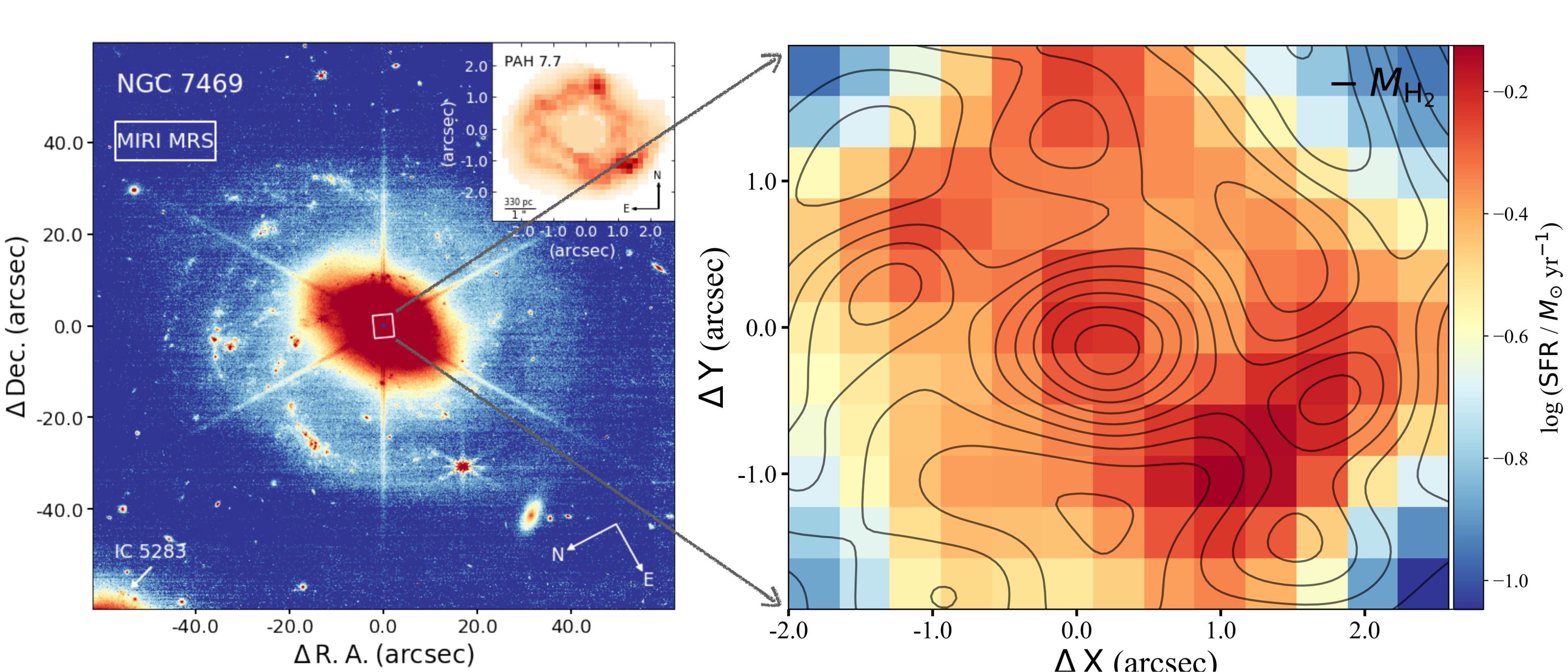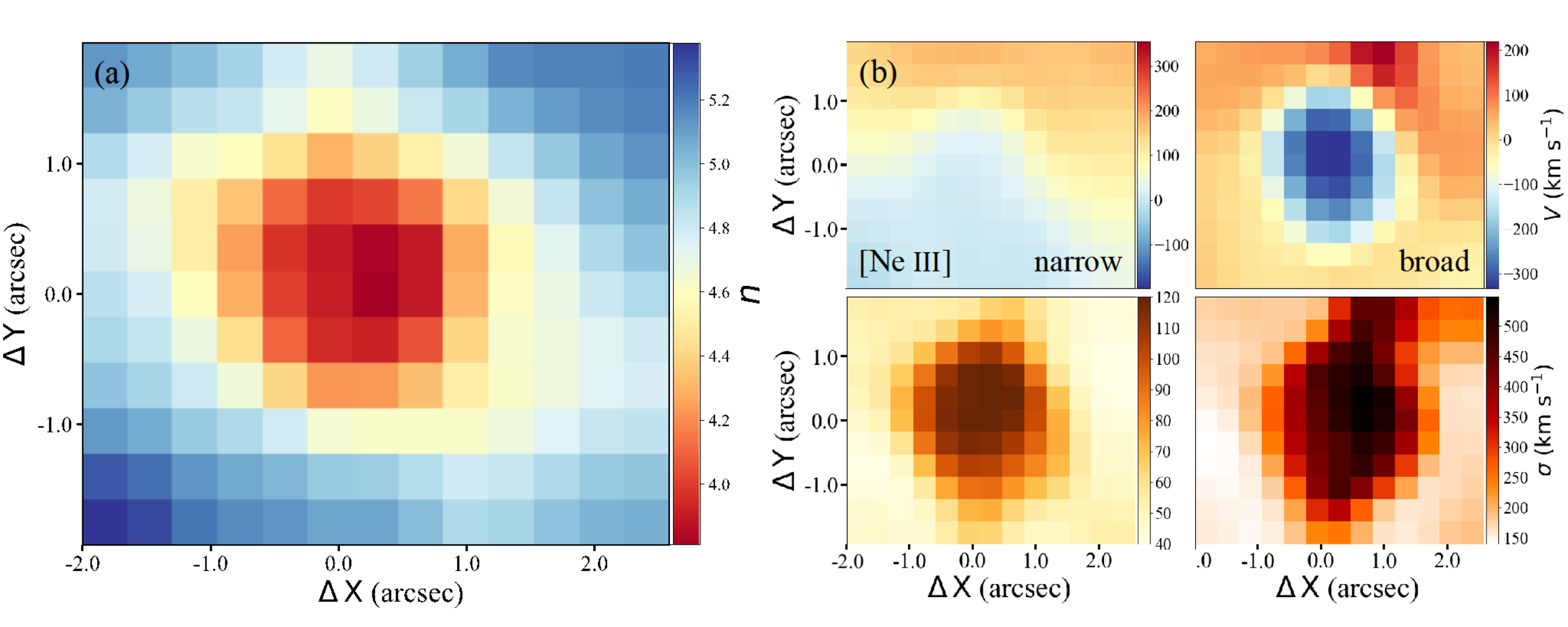With excellent sensitivity and spatial and spectral resolutions, the James Webb Space Telescope (JWST) presents an unprecedented opportunity to promote our understanding of the evolutionary processes of galaxies. Taking advantage of a recently available set of JWST observations taken with Medium Resolution Spectrograph (MRS) on the Mid-Infrared Instrument (MIRI), Dr. Lulu Zhang, who got his PhD degree this July from Peking University under the supervision of Prof. Luis C. Ho at the Kavli Institute for Astronomy and Astrophysics at Peking University, ascertained whether and the manner in which AGN feedback influences the circumnuclear star formation of the well-studied nearby luminous infrared galaxy, NGC 7469, which also hosts a powerful type 1 active galactic nucleus (AGN). Their findings appear in The Astrophysical Journal Letters (2023, 953, L9).
Grasping the nature of star formation within different environments is fundamental for understanding galaxy formation and evolution. Deciphering star formation activity in galaxies of diverse types and in different stages of their evolution involves consideration of multiple facets of their lifecycle. Of particular recent interest is the potential role played by AGN feedback in impacting the star formation properties of galaxies. Although AGN feedback has been incorporated into many state-of-the-art cosmological simulations of galaxy evolution, debate persists as to whether this mechanism effectively regulates the gas content and star formation activity in galaxies. And if so, which mode operates? AGN feedback can be negative, by expelling gas from galaxies and curtailing their ability or efficiency to form stars, or positive, by facilitating star formation through gas compression by outflows.
(Ultra)luminous infrared galaxies, or (U)LIRGs for short, provide an ideal laboratory to test the AGN feedback paradigm. The aftermath of gas-rich, major mergers, (U)LIRGs derive their power mostly from starburst activity, with an admixture of contribution from a dust-enshrouded AGN. In the merger-driven evolutionary scenario, gas funneled to the center of the merger remnant fuels a central starburst and obscured black hole growth, until energy feedback clears enough gas and dust to reveal an optically visible quasar, and ultimately a quiescent elliptical galaxy. In view of the complex internal substructure and severe extinction of (U)LIRGs, IR observations, especially when spatially resolved, afford the best opportunity to diagnose the physical nature of these complicated environments, and hence shed light on the feedback effects of AGN activity.

Figure 1: Illustration of the MIRI/MRS coverage (white rectangle) of NGC 7469 in the left, and the distribution of SFR within the central region of NGC 7469 in the right, with black contours indicating the distribution of H2 content.
Zhang & Ho found that the SFR distribution within the inner ∼ 1.5 kpc×1.3 kpc region of NGC 7469 shows a central peak, which accounts for only ∼ 1% of the total SFR captured in the mapped region, and an inhomogeneous ring-like structure with several hotspots that are concentrated largely toward the northeast and southwest directions (Figure 1), reminiscent of the morphology seen in previous radio and mid-IR observation. The distribution of H2 gas roughly traces the SFR map, while the molecular gas clumps along the circumnuclear ring are not spatially coincident with the star-forming hotspots. Intriguingly, molecular gas is piled up toward the nuclear region (within the central ∼ 1′′), in contrast to the distribution of SFR, which is most prominent in the hotspots on the ring.

Figure 2: The distribution of (a) SFE and (b) Toomre Q parameter within the central region of NGC 7469.
The mismatch between the gas and young stars is best seen in the distribution of the star formation efficiency, SFE = SFR/MH2 , which presents a minimum at the position of the nucleus, as well as in a gap at ∆Y = −0.3 in the eastern portion of the ring (Figure 2a), while the sites of most efficient conversion of gas to stars occur in two concentrations on the circumnuclear ring. The two sites of efficient star formation approximately coincide with the ends of the two spiraling gas arms visible in CO emission. The entire circumnuclear region of NGC 7469 is currently forming stars vigorously, with an efficiency that qualifies it as a starburst. The average gas depletion time along the ring is tdep ≡ SFE−1 ≈ 30 Myr, with values as low as ∼ 13 Myr in the hotspots. Even the nucleus and the eastern gap region have gas depletion times of ∼ 45 Myr, which are still significantly shorter than that of star-forming main sequence galaxies (tdep = 2.35 Gyr). Moreover, Figure 2b illustrates that except for a few pixels to the southeast of the nucleus, which roughly correspond to the nuclear minimum SFE region at (∆X, ∆Y) = (0.3, −0.3), the Toomre Q parameter has values less than 1 throughout most of the central region of NGC 7469, consistent with its starburst nature.

Figure 3: The distribution of (a) the power-law index n (related to temperature of H2) and (b) velocity field of the [Ne III] emission line within the central region of NGC 7469.
The distribution of power-law index n of the excitation temperature of the warm molecular gas obtained for the central region of NGC 7469 (Figure 3a) agrees well with the values of local IR-bright Seyfert galaxies and ULIRGs, while values of n are on average smaller—indicating higher hot gas fraction—than the mean value of nearby star-forming galaxies and low-luminosity AGNs. Most notably, values of n in the circumnuclear region of NGC 7469 gradually but systematically drop toward the nucleus, indicating a central rise in molecular gas temperature. These results suggest that the active nucleus drives some mechanism of gas heating in the central region, which may be responsible for the relatively depressed SFE in the center.
The higher ionization emission line of [Ne III] from the central region exhibits prominent blueshifted and redshifted motions, as well as large velocity dispersions, indicative of a bipolar sub-kpc ionized outflow (Figure 3b), which may contribute to reducing the SFE in the nucleus.
Despite the observable manifestations of NGC 7469’s highly accreting supermassive black hole, AGN feedback overall has a negligible impact on the cold circumnuclear medium or its ability to form stars. The circumnuclear ring of the galaxy remains a healthy starburst, and even the very nuclear region itself forms stars with substantial efficiency.
Paper Link: https://ui.adsabs.harvard.edu/abs/2023ApJ...953L...9Z/abstract